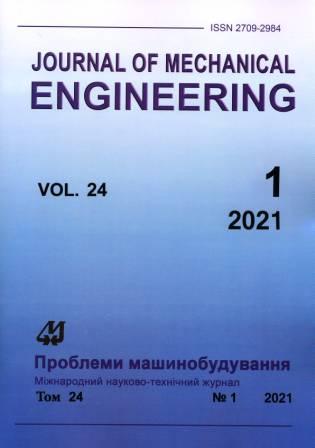До розв’язання геометричних обернених задач теплопровідності
Анотація
На основі теорії регуляризації А. М. Тихонова розроблена методика розв'язання обернених задач теплопровідності з ідентифікації гладкої зовнішньої межі двовимірної області за відомих на ній граничних умов. Для цього гладка межа апроксимується кубічними сплайнами Шьонберга, внаслідок чого її ідентифікація зводиться до визначення невідомих коефіцієнтів в цій апроксимації. За відомих граничних і початкових умов температура в тілі буде залежати тільки від цих коефіцієнтів. Виразивши її за формулою Тейлора для двох членів ряду і підставивши в функціонал Тихонова, задачу визначення збільшень коефіцієнтів можна звести до розв’язання системи лінійних рівнянь щодо цих збільшень. Вибравши певний параметр регуляризації і деяку функцію, яка описує форму зовнішньої межі, як початкове наближення, можна реалізувати ітераційний процес. У цьому процесі вектор невідомих коефіцієнтів для поточної ітерації буде дорівнювати сумі вектора коефіцієнтів з попередньої ітерації і вектора приростів цих коефіцієнтів, отриманих в результаті розв’язання системи лінійних рівнянь. Отримавши вектор коефіцієнтів в результаті збіжного ітераційного процесу, можна визначити середньоквадратичний відхил між одержуваною температурою і температурою, що вимірюється в результаті проведеного експерименту. Залишається підібрати параметр регуляризації таким чином, щоб цей відхил був у межах середньоквадратичної похибки помилки вимірювань. У самій методиці та шляхах її реалізації полягає новизна викладеного у статті матеріалу в порівнянні з підходами інших авторів до розв’язання обернених геометричних задач теплопровідності. Під час перевірки ефективності використання запропонованої методики розв’язано низку двовимірних тестових задач для тіл з відомим розташуванням зовнішньої межі. Проведено аналіз впливу випадкових похибок вимірювань на похибку ідентифікації форми зовнішньої межі.
##submission.downloads##
Опубліковано
Номер
Розділ
Ліцензія
Авторське право (c) 2021 Yurii M. Matsevytyi, Valerii V. Hanchyn

Ця робота ліцензується відповідно до Creative Commons Attribution-NoDerivatives 4.0 International License.
Автори, які публікуються в цьому журналі, погоджуються з наступними умовами:
- Автори залишають за собою право на авторство своєї роботи і передають журналу право першої публікації цієї роботи на умовах ліцензійного договору (угоди).
- Автори мають право самостійно укладати додаткові договори (угоди) з неексклюзивного поширення роботи в тому вигляді, в якому вона була опублікована цим журналом (наприклад, розміщувати роботу в електронному сховищі установи або публікувати в складі монографії), за умови збереження посилання на першу публікацію роботи в цьому журналі.
- Політика журналу дозволяє розміщення авторами в мережі Інтернет (наприклад, у сховищах установи або на персональних веб-сайтах) рукопису роботи як до подачі цього рукопису в редакцію, так і під час її редакційної обробки, оскільки це сприяє виникненню продуктивної наукової дискусії і позитивно позначається на оперативності та динаміці цитування опублікованої роботи (див. The Effect of Open Access).

